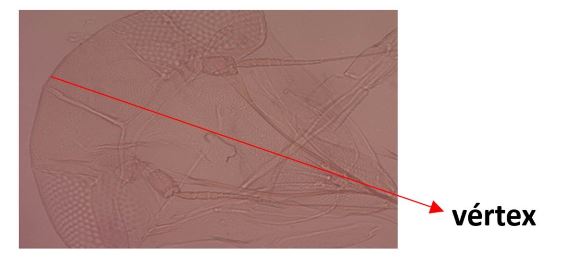First Report of Empoasca fabae Harris in sweet potato [Ipomoea batatas Lam.] in Cuba
Main Article Content
Abstract
The objective of this work was to identify a leafhopper species present in sweet potato in San José de las Lajas, Mayabeque province, Cuba. For this purpose, the specimens present on sweet potato leaves were collected, in the period from April to June 2015. The collected insects were cleared, mounted on slides, and observed under a Stemi 4 stereoscope and an Axiolab A1 microscope with monitor and coupled camera. Identification was done by using dicotomic keys. The leafhopper species determined was Empoasca fabae Harris. It is the first report of this species in sweet potato in Cuba.
Article Details

This work is licensed under a Creative Commons Attribution-NonCommercial 4.0 International License.
Aquellos autores/as que tengan publicaciones con esta revista, aceptan los términos siguientes:
- Los autores/as conservarán sus derechos de autor y garantizarán a la revista el derecho de primera publicación de su obra, el cual estará simultáneamente sujeto a la Licencia Creative Commons Attribution-NonCommercial 4.0 International (CC BY-NC 4.0) que permite a terceros compartir la obra, siempre que se indique su autor y la primera publicación en esta revista. Bajo esta licencia el autor será libre de:
- Compartir — copiar y redistribuir el material en cualquier medio o formato
- Adaptar — remezclar, transformar y crear a partir del material
- El licenciador no puede revocar estas libertades mientras cumpla con los términos de la licencia
Bajo las siguientes condiciones:
- Reconocimiento — Debe reconocer adecuadamente la autoría, proporcionar un enlace a la licencia e indicar si se han realizado cambios. Puede hacerlo de cualquier manera razonable, pero no de una manera que sugiera que tiene el apoyo del licenciador o lo recibe por el uso que hace.
- NoComercial — No puede utilizar el material para una finalidad comercial.
- No hay restricciones adicionales — No puede aplicar términos legales o medidas tecnológicas que legalmente restrinjan realizar aquello que la licencia permite.
- Los autores/as podrán adoptar otros acuerdos de licencia no exclusiva de distribución de la versión de la obra publicada (p. ej.: depositarla en un archivo telemático institucional o publicarla en un volumen monográfico) siempre que se indique la publicación inicial en esta revista.
- Se permite y recomienda a los autores/as difundir su obra a través de Internet (p. ej.: en archivos telemáticos institucionales o en su página web) antes y durante el proceso de envío, lo cual puede producir intercambios interesantes y aumentar las citas de la obra publicada. (Véase El efecto del acceso abierto).
References
Varela-Benavides I, Trejos-Araya C. Detección de virus en camote (Ipomoea batatas) mediante qPCR1. Agronomía Mesoamericana. Universidad de Costa Rica, Costa Rica; 2020;31(1):223–35. DOI: 10.15517/am.v31i1.37668
Barkessa MKE. A review on sweet potato (Ipomea batata) viruses and associated diseases. Int J Res Agric For. 2018;5(9):1–10.
Organización de las Naciones Unidas para la Agricultura y la Alimentación (FAO). [Internet]. 2019. La biodiversidad crucial para nuestra alimentación y agricultura desaparece de día en día [cited 2019 Mar 3]. Available from: http://www.fao.org/news/story/es/item/1181470/icode/
Folgueras MC, Castellón MC, Morales LM, Dávila A, González RE, Ventura V, González JE, Pons CC. Manual Práctico Manejo Integrado De Plagas en Raíces, Rizomas y Tubérculos Tropicales, Plátanos y Bananos. Villa Clara, Cuba: INIVIT; 2020: 29-37. ISBN 978-959-295-013-9
Castellón Valdés MC. Estudios biológicos y elementos para el manejo de Typophorus nigritus Fabricius (Coleoptera: Chrysomelidae) en plantaciones de boniato (Ipomoea batatas (L.) Lam.) [PhD Thesis]. Cuba: Universidad Central “Marta Abreu” de Las Villas. Facultad de Ciencias Agropecuarias; 2011. 100 pp
Caldwell JS, Martorell LF. Review of the Auchenorynchous Homoptera of Puerto Rico Part I Cicadellidae. Journal of Agriculture, University of Puerto Rico. 1952;34:1–132.
Sánchez A, Quiñones M, Piñol B, Fernández BM. Primer informe de Typhlocybinae como vectores potenciales de fitoplasmas en Cnidoscolus chayamansa (Miller) I.M. Johnst. (Chaya) en Cuba. Rev Protección Veg. 2015;30(2):148–57.
Ross HH, Cunningham HB. A Key to the Empoasca solana Complex with Descriptions of New Species. The Ohio Journal of Science. 1960;60(5):309–17.
Neilson MW. The leafhoppers vectors phytopathogenic viruses (Homoptera, Cicadellidae Taxonomy, Biology and Transmission. Washington DC: Agricultural Research Services, United States Department of Agriculture; 1968.
Langlitz HO. The Economic Species of Empoasca in the Coastal and Sierra, Regions of Perú. Revista Peruana de Entomología. 1968;7(1):54–70.
Lamp W, Nielsen G, Fuentes C, Quebedeaux B. Feeding Site Preference of Potato Leafhopper (Homoptera: Cicadellidae) on Alfalfa and its Effect on Photosynthesis. Journal of Agricultural and Urban Entomology. 2004;21(1):25–38. DOI: 10.24266/0738-2898-11.3.101
Potter D, Spicer P. Seasonal Phenology, Management, and Host Preferences of Potato Leafhopper on Nursery-Grown Maples. Journal of Environmental Horticulture. 1993;11(3):101–6. DOI: 10.24266/0738-2898-11.3.101
De Oliveira FS, Murilo FP, Nasser MD, de Albuquerque FA, Rupp MM. Manejo Integrado de insetos-praga da batata-doce. Revista de Agronegócio - Reagro, Jales. 2019;8(2).
Bland RG, Jaques HE. How to Know the Insects. 3rd ed. Waveland Press Inc.; 2010, 409p.
Distant W. Rhynchota- Homoptera. The Fauna of British India including Ceylon and Burma. Vol. 4 London: Secretary of State for India in Council; 1908. 501 pp
Qin D, Sihan L, Dietrich CH. A Key to the Genera of Empoascini in China. Florida Entomologist. 2014;97(4):1493–510. DOI: 10.1653/024.097.0425
DeLong D, Davidson R. Further Studies of the Genus Empoasca (Homoptera, Cicadellidae). Part III, Seventeen New Species of Empoasca from the United States and Canada. The Ohio Journal of Science. 1935;35(1):29–39. DOI: 10.1093/aesa/35.1.105
Dmitriev DA. Typhlocybinae: interactive keys and taxonomic databases, subfamily Typhlocybinae (version sep 2010). In: Species 2000 & ITIS Catalogue of Life: 2011 annual checklist. [Internet]. Reading, UK; 2011. Available from: http://www.catalogueoflife.org/annual-checklist/2011/details/species/id/7250927
Arroyo P, Pérez WH, Díaz Soto JA, Beltrán JH. Identificación de morfotipos de Empoasca spp. (Hemiptera: Cicadellidae) en agro-ecosistemas de ñame y yuca (Sucre, Colombia). Revista Colombiana de Entomología. 2015;41(2):163–9.
Backus EA, Serrano MS, Ranger CM. Mechanisms of Hopperburn: An Overview of Insect Taxonomy, Behavior, and Physiology. Annual Review of Entomology. 2005;50(1):125–51. DOI: 10.1146/annurev.ento.49.061802.123310
